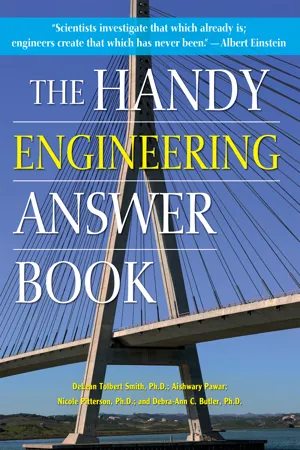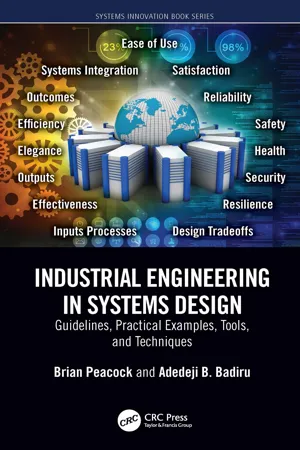Technology & Engineering
Aerospace Engineering
Aerospace engineering is the branch of engineering that deals with the design, development, and construction of aircraft and spacecraft. It involves the study of aerodynamics, propulsion systems, materials science, and structural design. Aerospace engineers work on a wide range of projects, from designing commercial airliners to developing cutting-edge space exploration technologies.
Written by Perlego with AI-assistance
Related key terms
4 Key excerpts on "Aerospace Engineering"
- eBook - ePub
- DeLean Tolbert Smith, Aishwary Pawar, Nicole P. Pitterson, Debra-Ann C. Butler(Authors)
- 2022(Publication Date)
- Visible Ink Press(Publisher)
Aerospace Engineering
What is Aerospace Engineering?Aerospace Engineering is the primary field of engineering concerned with the design, development, testing, and production of aircraft, spacecraft, and related systems and equipment. Aerospace engineers design primarily aircraft, spacecraft, satellites, and missiles. In addition, they test prototypes to make sure that they function according to the design of aircraft, spacecraft, missiles, and other airborne objects. Creating prototypes of these designs and testing them is also a primary responsibility of an aerospace engineer. But aerospace engineers also evaluate designs to see that the products meet engineering principles. Simply put, Aerospace Engineering is the process of designing, developing, testing, manufacturing, and producing anything that flies.What are the different branches of Aerospace Engineering?Aerospace Engineering has four main branches. This chapter will answer many questions related to the design of flight vehicles. This requires knowledge from many engineering disciplines, and some individuals and companies specialize in addressing these complex design challenges.•Aeronautical engineering involves the science and technology of aircraft design and propulsion systems inside of Earth’s atmosphere. In recent times, aeronautical engineers have commonly worked on military, commercial, and passenger jets; helicopters; and drones. In this field, an engineer can plan, design, and conduct wind tunnel tests for various aircraft models or different aircraft components, design and analyze airplane wing structures, and design and test jet engines. Aeronautical engineers use theory and technology and understand the fundamentals of flight to study the aerodynamic performance of materials.•Astronautical engineering involves work with science and technology on aircraft or spacecraft that operate outside of Earth’s atmosphere. This requires knowledge of space and the complexities of operating technology in space. Often known as “rocket science,” in this field, an engineer can design and test rocket engines; design, analyze, and optimize orbital trajectories (space routes); and develop control systems for rocket propulsion and space flight. - eBook - ePub
- (Author)
- 2014(Publication Date)
- Skyhorse(Publisher)
Aeronautical engineers work with aircraft. They are involved primarily in designing aircraft and propulsion systems and in studying the aerodynamic performance of aircraft and construction materials. They work with the theory, technology, and practice of flight within the earth’s atmosphere.Astronautical engineers work with the science and technology of spacecraft and how they perform inside and outside the earth’s atmosphere.Aeronautical and astronautical engineers face different environmental and operational issues in designing aircraft and spacecraft. However, the two fields overlap a great deal because they both depend on the basic principles of physics.Work EnvironmentAerospace engineers held about 83,000 jobs in 2012. They are employed in industries where workers design or build aircraft, missiles, systems for national defense, or spacecraft. Aerospace engineers work primarily for firms that engage in analysis and design, manufacturing, research and development, and for the federal government.The industries that employed the most aerospace engineers in 2012 were as follows:Aerospace product and parts manufacturing 38% Scientific research and development services 16 Architectural, engineering, and related services 12 Federal government 12 Navigational, measuring, electromedical, and control instruments manufacturing 6 Aerospace engineers now spend more of their time in an office environment than they have in the past, because modern aircraft design requires the use of sophisticated computer equipment and software design tools, modeling, and simulations for tests, evaluation, and training.Aerospace engineers work with other professionals involved in designing and building aircraft, spacecraft, and their components. Therefore, they must be able to communicate well, divide work into manageable tasks, and work with others toward a common goal.Work SchedulesAerospace engineers typically work full time. Engineers who direct projects must often work extra hours to monitor progress, to ensure that the design meets requirements, to determine how to measure aircraft performance, to see that production meets design standards, and to ensure that deadlines are met. - Avigdor Zonnenshain, Shuki Stauber(Authors)
- 2015(Publication Date)
- Wiley(Publisher)
Systems engineering knows how to take these things into account and integrate them into the engineering process. The engineering and the needs of the client have to go together, and this combination is what systems engineering is about. For example, one of the discipline's most salient terms is ‘requirements management.’ In the past, engineers did not give requirements the weight they deserved; they just developed as well as their professional abilities allowed them to. Today, it is clear that system requirements cannot be ignored, and must be a pivotal factor throughout the product's life cycle. This dramatic change in perception was instilled by systems engineering, and the new approach has now become part of the industry's methodology.”Systems Engineering and its Affinity with Aeronautics
Other chapters of our book have addressed the claim that systems engineering has evolved hand in hand with Aerospace Engineering. Prof. Aviv Rosen expands on this:“An aeronautical engineer's training is very similar to that of a systems engineer. Even during the 60s, back when I was a student in the Technion's Aerospace Engineering faculty, there was a conflict between the need to specialize in one of the various subdisciplines of aeronautics, and the need to train a ‘well balanced engineer,’ with background knowledge in all areas. The Technion had, and still has, faculties, where the students choose the course of their professional development within the faculty. For instance, the mechanical engineering faculty offered specializations in energy, production, and other areas. Aeronautics, however, argued that the uniqueness of the field is its multidisciplinary nature, an airplane being an interdisciplinary and multidisciplinary craft. An aeronautical engineer is a better engineer, if he sees the whole picture, rather than just the aerodynamics, structure or control systems.I, for instance, specialized in structures in my second and third degree studies, and only years later returned to the study of aerodynamics. I would not have taken that path if, during my first degree studies, I had specialized only in structures, without first being acquainted with the other areas. It is this exposure that creates within the student the openness to learning new things.- eBook - ePub
Industrial Engineering in Systems Design
Guidelines, Practical Examples, Tools, and Techniques
- Brian Peacock, Adedeji B. Badiru(Authors)
- 2023(Publication Date)
- CRC Press(Publisher)
7 Industrial Engineering in Aerospace Systems DesignDOI: 10.1201/9781003328445-7Introduction
Industrial engineering (IE) interest in aerospace has been growing rapidly in recent years. The emergence of renewed focus on space-related research, exploration, and development has created new opportunities for IE and its sub-fields, particularly the field of human factors (Peacock, 2019 , 2020 , 2021 ). This chapter focuses specifically on human factors in aerospace, as a core part of the theme of this book, entitled Industrial Engineering in Systems Design. This development is conveyed through Badiru (2022) , which is echoed below.As a professional organization, industrial engineers often wonder what is needed to continue to make the profession of IE relevant in a fast-changing world. Former astronaut Buzz Aldrin said it aptly, “We explore, or we expire”. Space exploration and industrialization offer one way of preempting human expiration. IEs can place a role in this regard. The rapid emergence of private space flights will expedite the creation and dissemination of new engineering and technology products that may very well help. Looking back on history, IE has contributed to the development, advancement, and sustainment of industries. Practical case examples of the diverse applicability of IE can still be seen in the auto and aerospace industries. The official definition of IE says it befittingly.
Index pages curate the most relevant extracts from our library of academic textbooks. They’ve been created using an in-house natural language model (NLM), each adding context and meaning to key research topics.



